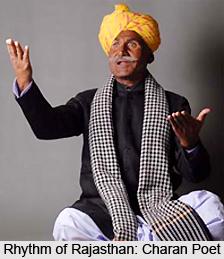 The contribution of Charan poetry in shaping Rajasthani literature has been invaluable. Charan style poetry evolved in both ancient and medieval eras in Rajasthan. This form of Rajasthani poetry is so named after the community of the Charans. The relations between the Charans and the Rajputs were deep-rooted in history. The Charan poets used to accompany their heroes to the battlefields. Many a time, they used to participate in fighting. They were witnesses not only to battles but also to many other occasions and episodes forming part of the contemporary Rajput life. The poems composed about such happenings, poetic exaggerations apart, had two qualities: basic historical truth and vivid, realistic and pictorial descriptions, particularly of heroes, heroic deeds and battles. Charan poetry knows no parallel and has rightly been lauded by scholars.
The contribution of Charan poetry in shaping Rajasthani literature has been invaluable. Charan style poetry evolved in both ancient and medieval eras in Rajasthan. This form of Rajasthani poetry is so named after the community of the Charans. The relations between the Charans and the Rajputs were deep-rooted in history. The Charan poets used to accompany their heroes to the battlefields. Many a time, they used to participate in fighting. They were witnesses not only to battles but also to many other occasions and episodes forming part of the contemporary Rajput life. The poems composed about such happenings, poetic exaggerations apart, had two qualities: basic historical truth and vivid, realistic and pictorial descriptions, particularly of heroes, heroic deeds and battles. Charan poetry knows no parallel and has rightly been lauded by scholars.
The Charan poetry is in two forms: narrative and stray. Both are mostly descriptive in style. The first goes by various names viz., Ras, Rasau, Rupak, Prakas, Charid, Vilas, Prabandh, Ayan, Sanvad, etc. These poems are also named after metres such as, Kavitt, Kundaliya, Jhulana, Nisani, Jhamal and Veli etc.
Stray poems have been written in various metres. Certain metres have been used in abundance in Charan poetry. These include Geet (Dingal Geet), Doha, Chappay, Nisani etc. Geet, in fact, appears to be the invention of the Charan poets. It is a unique feature of Rajasthani poetry. As doha is the most popular metre of Apabhramsa, so is the geet of Rajasthani. Geets are said to be of 120 types, but samples of all the types are not available. In the texts on prosody the number varies from 72 to 91. The geet is like a small poem. It is not sung but is recited in high-pitched tones in a peculiar style. Thousands of geets have been written in commemoration of historical deeds. They deal with both famous and obscure heroes and events. Many geets are contemporary compositions. Such compositions are called the poetry of testimony. The geets cover the life-span of the heroes. In a geet only one point pertaining to idea, feeling, sentiment or occurrence is repeated in all the stanzas, but due to obliqueness and craftsmanship of style, it does not appear to be mere repetition.
There are prosodic rules for the composition of a geet. They are `Jatha` (a special system of poetic composition; there are 18 types of Jatha), `Vayansagar (alliteration), and `Ukti` (a statement, the basis being the speaker, the listener and the object). A composition has to avoid the `dosas` (flaws), which are peculiar to the Charan prosody and are of 11 types. There are 22 types of chappay, 12 types of nisani, and 23 types of doha.













